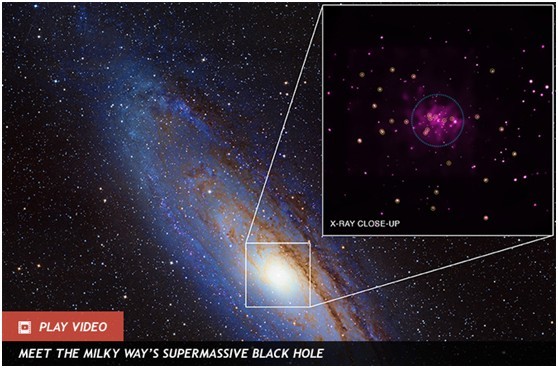
The central region of the Andromeda galaxy is chock-full of black holes, according to extensive observations with NASA’s Chandra X-ray Observatory. 26 new stellar-mass black hole candidates have been identified, adding to nine previously known and bringing the grand total to 35.
It might not sound like a lot compared to the size of an entire galaxy, but it’s many more than have been found so far in our own galaxy’s center and indicates the presence of even more that can’t be seen.
ANALYSIS: Black Hole Snoozes, Not Bothered With Eating Stuff
“While we are excited to find so many black holes in Andromeda, we think it’s just the tip of the iceberg,” said Robin Barnard of Harvard-Smithsonian Center for Astrophysics (CfA), lead author of a new paper describing these results. “Most black holes won’t have close companions and will be invisible to us.”
Using data from Chandra and the European Space Agency’s XMM-Newton X-ray Observatory, astronomers were able to spot these otherwise invisible objects by the energy released by superheated material they draw in from nearby stars.
More than 150 Chandra observations, spread over 13 years, were used to identify the 26 new black holes.
BIG PIC: See the Andromeda Galaxy in a Cool New Light
The image above combines optical data from the Warner and Swansey Observatory on Kitt Peak in Arizona with an inset of X-ray observations of the central region. The new black hole candidates are circled in yellow.
Chandra x-ray observations of M31′s core noting newly-discovered black holes (NASA/CXC/SAO/R.Barnard, Z.Lee et al.)
“By observing in snapshots covering more than a dozen years, we are able to build up a uniquely useful view of M31,” said co-author Michael Garcia, also of CfA. “The resulting very long exposure allows us to test if individual sources are black holes or neutron stars.”
While neutron stars would have exhibited a certain level of X-ray emission and wavelength, these sources were more energetic and brighter, indicating that they are very likely stellar-mass black holes — the collapsed remains of stars five to ten times the mass of our sun.
Because the Andromeda galaxy’s central bulge is bigger than the Milky Way’s, more black holes can form there — a scenario that was expected by astronomers and now supported by these Chandra results.
ANALYSIS: Andromeda’s Bling: Tiny Greedy Quasar Found
“When it comes to finding black holes in the central region of a galaxy, it is indeed the case where bigger is better,” said co-author Stephen Murray of Johns Hopkins University and CfA. “In the case of Andromeda we have a bigger bulge and a bigger supermassive black hole than in the Milky Way, so we expect more smaller black holes are made there as well.”
The team’s results will be published in the June 20 issue of The Astrophysical Journal.